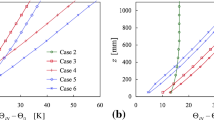Abstract
The maintenance of an elevated inversion in steady flow above a cold, rotating surface is shown to be possible for a certain range of the ‘buoyancy number’ bfV g, where b is the buoyant acceleration appropriate to the density deficiency of the fluid above the inversion, f is Coriolis parameter and V gis geostrophic velocity (so that fV gis also horizontal pressure gradient in kinematic units). The height of the inversion lid is determined by a balance of surface stress and buoyancy, in a way which may be deduced from laboratory experiments. With the aid of such empirical evidence a theory is constructed for the layer below the inversion lid. The cross-isobar angle of ground-level stress is found to increase with the buoyancy number, to a limiting value of 90‡, by which time the inversion descends to the ground. Under typical conditions, a temperature difference of order 10‡C is necessary to eliminate the possibility of an equilibrium, elevated inversion lid and reduce ground level wind stress to a vanishingly small value.
Similar content being viewed by others
References
Benson, C. S.: 1970, Ice Fog, Weather 25, 11–18.
Blackadar, A. K. and Tennekes, H.: 1968, Asymptotic similarity in neutral barotropic planetary boundary layers, J. Atmospheric Sci. 25, 1015–1020.
Chow, Ven Te: 1959, Open Channel Hydraulics. McGraw Hill Book Co.
Clarke, R. H.: 1970, ‘Observational studies in the atmospheric boundary layer’, Quart. J. Roy. Met. Soc. 96, 91–114.
Clauser, F. H.: 1956, The turbulent boundary layer, Adv. Appl. Mech. 4, 1–51.
Csanady, G. T.: 1967, On the resistance law of a turbulent Ekman Layer, J. Atmos. Sci. 24, 467–471.
Csanady, G. T.: 1972a, Geostrophic drag, heat and mass transfer coefficients for the diabatic Ekman Layer, J. Atmos. Sci. 29, 488–496.
Csanady, G. T.: 1972b, Frictional Currents in the mixed layer at the Sea Surface, J. Phys. Oceanogr. 2, 498–508.
Csanady, G. T.: 1972c, The coastal boundary layer in Lake Ontario, pt. I, the spring regime, J. Phys. Oceanogr. 2, 41–53.
Ellison, T. H. and Turner, J. S.: 1959, Turbulent entrainment in stratified flows, J. Fluid Mech. 6, 423–448.
Geisler, J. E. and Kraus, E. B.: 1969, The well-mixed Ekman boundary-layer, Deep Sea Res. Suppl. to Vol. 16, 73–84.
Gonella, J.: 1971, The drift current from observations made on the Bouée Laboratoire, Cahiers Oceanogr. 23, 19–33.
Hanna, S. R.: 1969, Characteristics of Winds and Turbulence in the planetary Boundary-Layer. U.S. Dept of Comm. ESSA Air Resources Laboratory Tech. Memo. No. 8, 61 pp.
Kato, H. and Phillips, O. M.: 1969, On the penetration of a turbulent layer into stratified fluid, J. Fluid Mech 37, 643–655.
Kraus, E. B.: 1968, What we do not know about the sea surface wind stress, Bull. Am. Meteorol. Soc. 49, 247–253.
Lettau, H. H.: 1962, Theoretical wind spirals in the boundary-layer of a barotropic atmosphere, Beiträge Phys. Atmos. 35, 195–212.
Lofquist, K.: 1960, Flow and stress near an interface between stratified liquids, Phys. Fluids 3, 158–175.
Monin, A. S.: 1970, The atmospheric boundary-layer, Annual Rev. Fluid Mech. 2, 225–250.
Moore, M. J. and Long, R. R.: 1971, An experimental investigation of turbulent stratified shearing flow, J. Fluid Mech. 49, 635–656.
Plate, E. J.: 1971, ‘Aerodynamic Characteristics of Atmospheric Boundary-Layers’. AEC critical review series, US Atomic Energy Commission Division of Technical Information, 190 pp.
Pollard, R. T., Rhines, P. B., and Thompson, R. O. R. Y.: 1972, ‘The deepening of the wind-mixed layer’. Contr. No. 2789, Woods Hole Oceanogr. Inst.
Ragotzkie, R. A.: 1962, Effect of air stability on the development of wind waves on lakes, Limnol. and Ocean 7, 248–251.
Schlichting, H.: 1960, Boundary-Layer Theory, McGraw Hill Book Co., 647 pp.
Thompson, R. O. R. Y.: 1972, ‘Stratified Ekman Boundary Layer Models — Bottom and Top’, Woods Hole Oceanogr. Inst.
Turner, J. S.: 1968, The influence of molecular diffusivity on turbulent entrainment across a density interface, J. Fluid Mech. 33, 639–656.
Venkatesh, S. and Csanady, G. T.: 1973, A baroclinic Ekman Layer Model, University of Waterloo, Ontario, Canada.
Woods, J. D.: 1968, Wave-induced shear instability in the summer thermocline, J. Fluid Mech. 32, 791–800.
Author information
Authors and Affiliations
Additional information
Woods Hole Oceanographic Institution Contribution #3011
On leave from the University of Waterloo, Ontario
Rights and permissions
About this article
Cite this article
Csanady, G.T. Equilibrium theory of the planetary boundary layer with an inversion lid. Boundary-Layer Meteorol 6, 63–79 (1974). https://doi.org/10.1007/BF00232477
Revised:
Issue Date:
DOI: https://doi.org/10.1007/BF00232477




